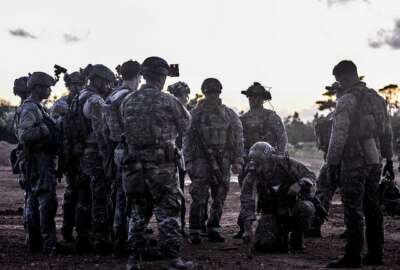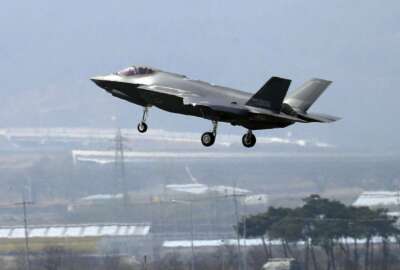
Air Force getting big response to squadron revitalization, making moves on pilot shortage
The Air Force is getting about 5,000 visitors a day on its site created to aggregate ideas on how to better squadrons.
The Air Force is getting a substantial return on its crowdsourcing effort to revitalize its squadrons.
The service is receiving about 5,000 visits per day from airmen interested in commenting, sharing and voting on ideas that will better squadron units, Brig. Gen. Stephen Davis, head of the Revitalizing Air Force Squadrons Task Force, said in an exclusive interview with Federal News Radio.
The Air Force received about 200 ideas so far from the website. The crowdsourcing model was inspired by the Airmen Powered by Innovation (API) website, which received a groundswell of ideas from airmen to change the way the Air Force works.
“The great news is we got 12,000 ideas [from API]. The bad news is we had to work through 12,000 ideas. Some of them were duplicates, some were great and some were not as good. It was a real challenge just to manage that. So what attracted us to the crowdsourcing approach was that we’ll put these ideas out there, and airmen can comment on them; airmen can vote, most importantly, and that will drive certain ideas to the top,” Davis said May 19.
The crowdsourcing initiative is part of a larger push started by Air Force Chief of Staff Gen. David Goldfein to fundamentally change the service.
“The squadron is the basic building block of the United States Air Force, where most airmen will service their first assignments, where they learn about the Air Force, where they get the culture of the Air Force and the chief believes strongly if we can make our squadron better then we will produce better airmen and that will lead to better warfighting,” Davis said.
The Squad Revitalization Task Force has already conducted 12 base visits and interviewed more than 1,000 airmen.
But Davis said the task force still wanted to branch further out than just the 25 bases it’s expected to visit over its information finding stage.
Crowdsourcing, Davis said, allows the task force to reach much more airmen in farther reaches of the service.
“The fact is that the Air Force has over 320,000 airmen,” Davis said.
Over the next month, the website will ask airmen to weigh in on a handful of issues.
The site will present five different “challenges” for airmen to solve. The first deals purely with improving the website airmen are using to comment on ideas. Input will revolve around usability of the site and its function.
The rest of the challenges revolve around personnel issues.
The task force wants to hear ideas on displaying squadron identity and how to implement it across the Air Force.
Another challenge deals with family: the service is looking for ways to better support service members’ families. The site will also ask how squadrons can stay focused on their core mission and the things that directly support it.
The final challenge is purely an open idea forum for any other ideas to improve squadrons.
The task force is periodically checking in with Goldfein and will give him a series of initial recommendations in the fall.
The task force will continue its work, however, over the next four years.
Davis said the biggest issues he heard so far revolved around additional duties and training. Airmen are feeling overburdened by extra duties and required training.
Over the years as civilian jobs have been cut and the Air Force has downsized, more duties like custodial work and safety management have fallen to airmen.
Additional training has also piled up over the years.
The Air Force took some steps last year to cut some training and duties.
The Air Force released a list of the courses that will be eliminated or streamlined. A computer-based, 20-minute training course providing an introduction to the role of the Inspector General got the ax.
The service cut 21 additional duties as well.
Pilots
The Air Force has barely changed its squadron structure in the last half century. Yet many experts believe the way squadrons operate is hurting the Air Force’s retention numbers.
Davis said based on what he sees, Air Force morale is doing well. But the service is seeing increasing deficits in key occupational positions.
Latest Air Force News
The Air Force is short more than 1,500 pilots, largely due to pilots choosing to go to private airlines rather than reenlist.
Goldfein hosted a National Pilot Sourcing meeting last week with airline executives to ensure high quality pilots of the needs of the nation.
RAND, the University of North Dakota, the National Air Carrier Association, Airlines for America, Civil Air Patrol, the Regional Airline Association and the Air Force briefed participants.
“I need 1,200 [pilots] a year, [the airlines] need 4,500 a year, for 10 years. They exhaust my supply pretty quick and they exhaust our supply pretty quick, so the next place they are going to go is international,” Goldfein told Federal News Radio last month. “We really have to look at this holistically to say ‘What are the nation’s needs for a pilot force to do commercial business, private and military aviation?’ and then ‘How do we look at new creative ways of plussing-up the supply.”
A May 19 press release from the Air Force stated the Air Force and airline executives decided to work together to provide more accessible pathways for students of aviation to reach their goal and to create new pathways to becoming a pilot.
“Today’s aviation enterprise doesn’t adequately meet the needs for national defense and national commerce,” said Goldfein. “This is the beginning of something I think will have big payoffs if we’re disciplined in the way we approach it.”
Copyright © 2025 Federal News Network. All rights reserved. This website is not intended for users located within the European Economic Area.
Scott Maucione is a defense reporter for Federal News Network and reports on human capital, workforce and the Defense Department at-large.
Follow @smaucioneWFED





